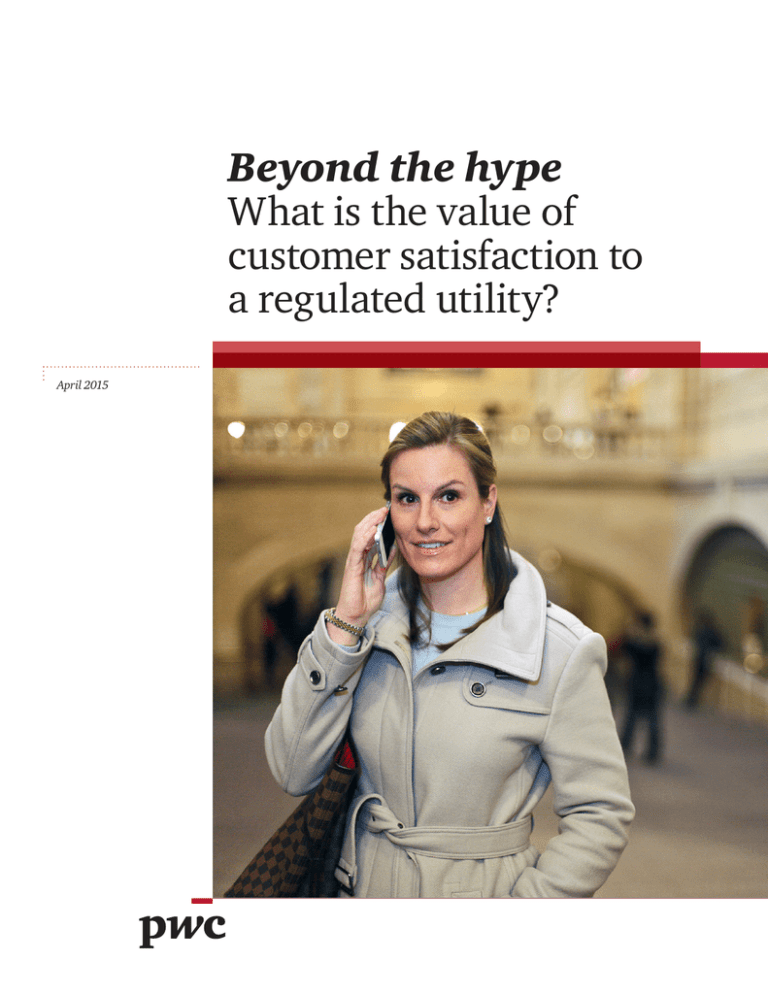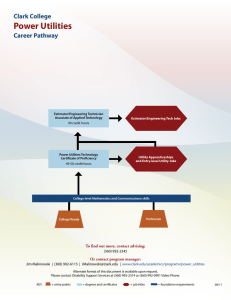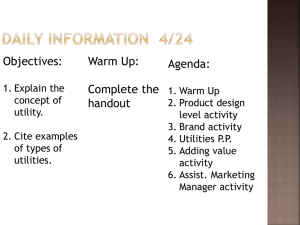
Beyond the hype
What is the value of
customer satisfaction to
a regulated utility?
April 2015
Beyond the hype
What is the value of customer
satisfaction to a regulated utility?
2
Beyond the hype: What is the value of customer satisfaction to a regulated utility?
The “traditional”
customer-utility model
is rapidly evolving as a
result of new technology,
competition, an evolving
smart grid, and an
increasingly tech-savvy
consumer class. Across
industries, businesses
are being told that
customer satisfaction
should be a priority, and
that it’s not only good
for customers, it’s good
for business. However,
do happier customers
translate into real value
for utilities, especially
regulated monopolies with
a captive customer base?
This question has been
difficult to answer with
certainty—even as these
same utilities dedicate
significant resources to
play catch-up in providing
a superior experience
that can increase
customer satisfaction.
To get to an answer that goes beyond
the hype, we’ve conducted research
focused specifically on answering “what
is the value of customer satisfaction to a
regulated utility?” The short answer is:
Customer satisfaction does translate
into real and tangible value for power
and utility companies in a number
of ways and is indeed better for
business.
Overview of key findings:
• Customer satisfaction is clearly
an important factor in regulatory
outcomes. While our analysis
does not point to a direct causeand-effect relationship between
customer satisfaction levels and
higher authorized returns on rate
base, maintaining a minimum level of
customer satisfaction appears to make
a difference when regulated utilities
seek a rate increase.
• Customer satisfaction as a
competitive differentiator can be
instrumental for utilities seeking
growth via new unregulated
services and products, or
protecting their core business from
disruptive entrants. Higher levels of
consumer trust and confidence can
raise the barriers for market entrants
creating disruption and discourage
your customer base from making a
change to an unknown and untried
service provider.
• Utilities are investing in customer
experience and the baseline
customer satisfaction level is rising.
There appears to be a race among
utilities to deliver the best experience
within the industry and the bar for
staying in the top quartile of customer
satisfaction keeps getting reset—
and higher.
To keep pace with the “changing
customer”, utilities should create the
foundation for a superior experience
by simplifying complex interactions,
personalizing interactions through the
application of advanced analytics to
customer data, and proactively seek
opportunities and take actions that drive
customer loyalty. Now is the time to
act: because consumers today are more
engaged with their energy consumption
and do so through various technology
tools and mediums, utilities have an
enviable opportunity to shape the
customer experience in ways that may
not have been previously possible.
In the sections to follow, we’ll explore
further what it “means” to have satisfied
customers drive value for your business,
and offer recommendations on the
actions to take to get the greatest value
from customer experience investments.
3
What are the tangible benefits to
having “Satisfied Customers”?
Customer satisfaction is a measure
of the positive experience customers
have when interacting with a company
and thus can be viewed as an outcome
of a positive customer experience.
Maintaining at least a minimum level
of customer satisfaction appears to
make a difference in the rate case
process when regulated utilities seek
to establish the return on their rate
base. Our analysis suggests there is
a relationship between the customersatisfaction metric developed by J.D.
Power and Associates and the outcomes
of these regulated utilities’ requests for
rate increases. Utilities with a lower
score in the customer satisfaction metric
appear less likely to receive a high
portion of their requested return on
rate base.
Although there are many factors that
influence regulatory outcomes, we
found that utilities with lower customer
satisfaction than their industry peers
were less successful in rate negotiations.
Specifically, utilities in the bottom
quartile of customer satisfaction were
granted a lower percentage of the
requested rate of return than utilities in
the top quartile (see Figure)
Utilities with higher customer satisfaction achieved better regulatory outcomes
Utility rate case success compared to Customer Satisfaction (CSAT)
Percent of requested RORB authorized
1.05
1.00
0.95
0.90
0.85
THE CEILING: There is a
point of diminishing
returns to improving CSAT
THE FLOOR: Utilities
in the bottom quartile
saw a steep drop in
regulatory returns
0.80
550
570
590
610
630
650
670
690
Customer Satisfaction Score (JDP, actual, 2009-2013)
Quartile 1
Quartile 2
Quartile 3
The debt component of return on rate base is based
on interest rates of outstanding debt and often has
a smaller delta between requested and authorized
amounts. Thus, the benefits of higher customer
satisfaction would contribute primarily to the negotiation
over the equity component of return on rate base.
4
Quartile 4
*Percent of requested Return on Rate Base calculated
as the ratio of requested RORB and actual RORB
for each case of rate adjustment published in SNL
Rate Case History reports. Customer Satisfaction
score in each year corresponding to rate request is
plotted to the ratio. Source: JD Power Gas Utility
Beyond the hype: What is the value of customer satisfaction to a regulated utility?
Industry reports (2009, 2010, 2011, 2012 and 2013);
SNL Industry reports and Rate Case History, data
obtained 11/01/2014
Note: Companies represented in each plot may vary,
according to available information and data
Customer satisfaction is a measure of the positive
experience customers have when interacting with a
company and thus can be viewed as an outcome of a
positive customer experience.
While our analysis has not
found a direct cause-andeffect relationship between
customer satisfaction levels
and authorized rate of returns,
customer satisfaction is clearly
an important factor in regulatory
negotiations.
Customer satisfaction levels often
receive higher attention from regulators
in the aftermath of widespread
reliability issues, such as following major
storms, or when customer satisfaction
is consistently low or has recently
declined. In such contexts, utilities can
expect heightened regulatory scrutiny
of their customer-service performance.
For example, after a utility experienced
a decline in customer satisfaction
levels over a two year period, the State
Public Service Commission required an
audit of this utility’s customer-service
practices. The audit report attributed
the decline to aggressive cost cutting,
a failed implementation of a new
online customer channel, and a lack
of commitment to customer service. In
response, the utility made an investment
to improve customer service, particularly
through digital channels. The utility
invested capital and increased operating
expenses to shore up the customer
service function and regain customer
satisfaction which ultimately eroded
the cost savings they had originally
achieved.
How do I capture the full benefits
of customer satisfaction?
To capture the full benefits of customer
satisfaction, utilities need to regard
themselves as incumbents in their core
business and, potentially, as entrants
into new service areas. In each role,
they will have specific opportunities
to make investments in customer
service and operations that promote
customer satisfaction and help to
differentiate them from the competition.
Higher levels of consumer trust and
confidence can raise the barriers for
market entrants creating disruption and
discourage your customer base from
making a change for an “unknown”
and “untried” service provider. Our
analysis suggests that utilities in general
“agree” as investments in customer
experience along with baseline customer
satisfaction levels are rising. And, the
bar for staying in the top quartile of
customer satisfaction keeps getting
reset—and higher as the race among
utilities to deliver the best experience
within the industry is intensifying.
When exploring new services or
products, utilities should consider the
experience that incumbents deliver and
the corresponding level of customer
satisfaction. A new entrant must deliver
a superior experience and exceed
current customer expectations to grab
market share and grow revenue. On
the other hand, to defend their core
business against innovative, disruptive
entrants, utilities need to maintain their
focus on customer satisfaction through
continual improvements in customer
service and innovative product and/or
service offerings.
Certain industries have been disrupted
by new entrants that deliver especially
high customer satisfaction. Netflix,
Apple, and Amazon are some companies
that are harnessing technology to
deliver impressive customer experiences
and consequently are achieving high
customer satisfaction levels and revenue
growth, as shown below.
5
Revenue growth compared to CSAT
Across industries, companies delivering higher customer satisfaction levels have also seen significant increases in revenue CAGR.
Total Revenue CAGR (2009–13)
50%
Apple
40%
30%
Netflix
20%
Amazon
Comcast
eBay
DirecTv
10%
Charter
0%
55
-10%
60
65
Overstock
Verizon
Time Warner
AT&T 70
T—Mobile
75
80
85
90
Sprint
Average customer satisfaction score (ACSI, 2009–13)
Size of the bubble based on 2013 revenue
*Source: ACSI Customer Satisfaction by company; Financial data sourced from SNL Company snapshots
The airline industry provides another example
where higher customer satisfaction can have an
impact on market share growth.
6
Beyond the hype: What is the value of customer satisfaction to a regulated utility?
Airline Industry—Market share vs. CSAT
1%
5%
10%
16%
80%
15%
16%
18%
60%
13%
14%
40%
16%
7%
8%
20%
0%
35%
26%
2002
2013
Jet Blue
Southwest
Delta
American
Southwest’s
market share
has increased
by 60%,
a 4% CAGR
over the period
90%
85%
ACSI Customer satisfaction score
Share of domestic revenue passenger miles (%)
100%
83
81
80%
75%
70%
68
65
65%
64
62
60%
55%
50%
United
US Airways
Other airlines
2013
JetBlue Airways
Southwest
Delta
American
US Airways
United
*Source: United States Department of Transportation, Bureau of Transport
Statistics, http://www.transtats.bts.gov/Data_Elements.aspx; ACSI Customer Satisfaction index for airline industry
7
Utilities have traditionally taken pride in providing
“safe, reliable, and affordable” energy and this
promise should continue to lie at the heart of their
value proposition.
In these examples, high customer
satisfaction is clearly not the only driver
of revenue and market share gains.
However, it is difficult to ignore the
high customer satisfaction achieved
by companies such as Netflix or
Southwest, as a leading indicator of the
differentiated customer experience and
its role in capturing market share.
How do I keep up with evolving
customer demands and create a
superior customer experience?
Solar panels and energy management
devices, among other technologies
have opened up a new world of energy
supply and control possibilities for
customers. As a result, some customers
are becoming more attuned to their
energy consumption and thinking
about their energy and the relationship
with their utility in new and different
ways. For the incumbent utility, the
increased penetration of advanced
metering infrastructure (AMI) and
“behind the meter” devices has
created more potential interactions
between customers and their energy
utilities. This means there are
more opportunities to please—or
displease—customers with the service
they receive. Moreover, customers
are demanding multichannel access to
utilities through call centers, web sites,
mobile apps, and walk-in centers. They
want the convenience and availability
of digital technology, including mobile
and social media, to enable easier
and simplified use of services, get
information from the utility and other
customers, and express their opinions.
8
To meet these evolving customer demands
for digitally supported interactions,
utilities should:
1. Create the foundation. To simplify
complex interactions and create
enjoyable experiences, utilities
should focus on their highest-volume
interactions—billing, field service,
and outages. The start-service
experience should be the highest
priority, so that new customer
relationships begin with a positive
first impression. Utilities should
segment the start-service experience
into each of its components, from
receiving the request and initiating
service to providing the first bill, and
strive for excellence throughout the
end-to-end process.
2.Personalize interactions. Today’s
consumers expect personalized
interactions, which means that
utilities must take a more fine-grained
approach to providing products and
services than traditional customer
segmentations allow for. Fortunately,
by applying advanced analytics to
increasingly available customer
data, utilities can gain insights
into customer preferences on an
individual level and tailor products
and services accordingly—offering
them at the right time and through
the right channel. Understanding the
preferences of self-service customers
is critical. In addition, timely and
personalized communications about
outage events can work to ease
customer dissatisfaction during
uncertain and emotional situations.
Beyond the hype: What is the value of customer satisfaction to a regulated utility?
3.Add value. When designing a
personalized customer experience,
it is essential that utilities maintain
a sharp focus on providing valueadded products and services. This
value-added focus will require a
significant mindset shift for utilities
that have spent generations providing
commoditized products and
services to ratepayers. The ultimate
aspiration should be to motivate
customers to proactively pursue new
and different ways to engage with
a utility, in contrast to customers
regarding such interactions as a
necessary inconvenience.
For many utilities, the starting point on
the journey to providing a value-added
customer experience will begin with
applying this new mindset to customer
service and operations. Utilities can
apply advanced analytics to anticipate
customer behavior and take proactive
steps to resolve situations before they
become bigger problems. For example,
analyses of customer inquiries can be
used to proactively address area-wide
service problems and resolve issues
before most customers contact the
utility. The mobile and social media
strategies included in the foundation of
the customer experience are essential
elements of a value-added approach to
service and operations. Utilities should
strive for mobile and social interactions
that enhance service and operations and
provide measurable outcomes.
Beyond value-added customer service
and operations, utilities that provide
a truly superior customer experience
will offer innovative products and
services that meet “customers”
evolving needs. Achieving this goal will
require building capabilities to identify
what customers really want based on
analyses of consumption and behavior.
Utilities may also want to accelerate
the speed of product development to
keep pace with rapidly changing trends
and demands.
As incumbents, utilities should take
advantage of their position to become
the “go-to resource” for meeting
customers’ evolving energy needs.
Success will require creating an
ecosystem of partners to serve broader
customer wants and expectations, such
as connecting customers with ancillary
energy services—including solar
providers, water heater installation, and
energy efficiency products.
What can I do now?
A utility should take three steps
to begin its journey to providing a
superior customer experience and
promoting world-class levels of customer
satisfaction. Utilities that fail to master
any one of these steps are likely to fall
short of their customer-experience goals.
First, utilities should define a
customer experience that is aligned
with their brand promise. Utilities
have traditionally taken pride in
providing “safe, reliable, and affordable”
energy and this promise should
continue to lie at the heart of their value
proposition. However, some utilities may
wish to expand their brand promise,
striving to become customers’ “go to”
energy adviser. For example, Powershop,
a New Zealand company, has achieved
world-class customer satisfaction ratings
by defining itself as an electric utility
“where you make the rules.” Customers
can instantly access their energy usage
and costs, pay in advance or as they
use energy, and take advantage of
frequent discounts.
Utilities should conduct a formal
maturity assessment to understand their
current performance in each of the five
attributes of customer experience.
For some utilities, this assessment
will reveal areas of strength for which
continued investment will create
a valuable source of competitive
differentiation and brand building.
However, most utilities are likely
to find one or more attributes
requiring additional investments to
reach the levels expected by today’s
demanding consumers.
Five attributes of customer experience.
Quality
Performance and
value received
Support
Friendliness and ease
of receiving help
Convenience
Anywhere,
anytime access
Presentation
Aesthetics, arrangement,
and pride in presentation
Community
Customer’s personal brand
and connections with others
9
Second, utilities should take an
inventory of all projects, programs,
and committees that are trying
to move the needle on customer
experience and satisfaction, such
as website redesign or social media
strategy definition. These efforts
are often dispersed throughout an
organization and conducted without
central oversight. Once a utility has
identified “who, what, when, and
where” for each of these initiatives, it
should seek to centrally coordinate them
and give them executive-level oversight
and exposure. To build momentum
and seize opportunities to innovate, all
initiatives should aim to achieve small,
agile improvements at a fast pace and
allow for continual refinements along
the way. In today’s rapidly changing
environment, big capital projects
related to customer experience are at
risk of obsolescence before they can
deliver results.
10
Finally, utilities need to transition
to a culture in which employees are
focused on the customer experience
and prepared to design and support
innovative approaches that raise
customer satisfaction. Customer
experience programs will not deliver
their intended results without such a
supporting culture. Transitioning from
an engineering culture to a customercentered culture is a significant change
and will require training and new
organizational enablers.
Utilities that apply these insights and
define a robust customer-experience
strategy can be better positioned to
weather the challenges of evolving
customer demands and a changing
customer-utility business model.
Utilities successful in securing satisfied
customers stand to gain tangible
business benefits that go beyond simply
having “happy customers.”
Beyond the hype: What is the value of customer satisfaction to a regulated utility?
11
www.pwc.com
To have a deeper conversation
about how this subject
may affect your business,
please contact:
Jim Curtin
PwC | Principal
+1 (281) 794 2698
james.m.curtin@us.pwc.com
Geoff Plese
PwC | Managing Director
+1 (678) 419 1585/+1 (678) 428 3876
geoffrey.e.plese@us.pwc.com
pwc.com
© 2015 PricewaterhouseCoopers LLP, a Delaware limited liability partnership. All rights reserved. PwC refers to the US member firm, and may sometimes refer to the
PwC network. Each member firm is a separate legal entity. Please see www.pwc.com/structure for further details. This content is for general information purposes only,
and should not be used as a substitute for consultation with professional advisors. MW-15-1920






